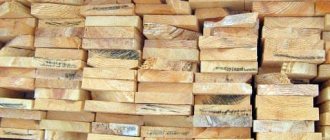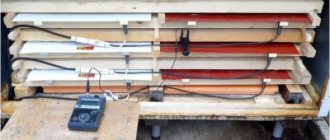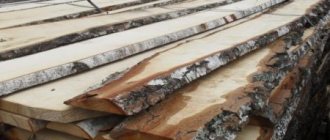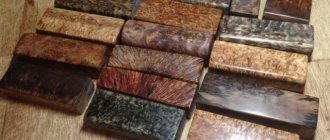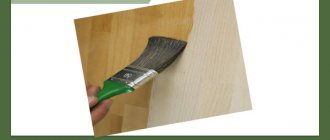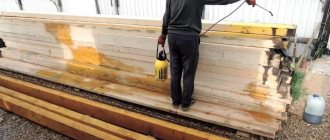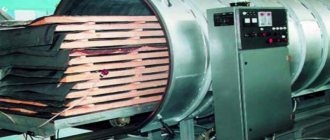Types of wood drying
In this section, we suggest that you familiarize yourself with all possible types of drying and their features. This will allow you to choose the option most suitable for specific conditions.
Natural - the safest and most budget-friendly
Natural drying involves simple and accessible drying of wood material. However, the process takes a long time - from 3 to 6 months. At the same time, it turns out to be quite gentle and comfortable. It does not require the use of special equipment and does not subsequently provoke deformation of the material.
Drying wood material using professional chambers Source ecostroy-complex.ru
But to organize this method, it is necessary to provide enough free space. It is desirable that this be a large-scale area with a canopy on top. It is necessary to prevent direct exposure of the raw wood material to sunlight. This will cause premature deformation, which will further affect the strength of the raw material.
Natural drying conditions for wood make it possible to reduce the moisture content in wood from 80-100% to 18-20%. A significant disadvantage is the long period and low intensity of drying.
Artificial in chambers - with resource costs
Drying in chambers naturally is a more profitable and faster, but at the same time energy-consuming option. This method can reduce wood moisture content to 10-18%. However, the aggressive impact of the equipment can cause various types of defects and damage to the integrity of the lumber.
Artificial drying of wood material is carried out in special “hot chambers” Source prostanki.com
Home drying of wood
In addition to industrial methods of drying wood, there are also home ones.
Using a microwave
The advantages of this method are that when it is used, tiny cracks do not form in solid wood, which can turn up to one and a half centimeters of material from each end into waste, and in some cases even break the workpiece into pieces. Under the influence of microwave heating, changes occur in the lignin fibers, due to which an object dried in this way loses its sensitivity to sudden changes in humidity.
For the drying procedure, a not too powerful, budget microwave model without unnecessary options is suitable. The main thing is that it has a low power mode. It usually corresponds to o, or "defrosting". The chamber must be large enough to accommodate crafts or wooden pieces. Often the chamber is larger in width than in depth.
Microwave drying of wood: technology
It is more convenient to dry individual pieces entirely; some are better cut into pieces. If it is already known what they are intended for, then they are cut to the size of future products, with an allowance. It is allowed to dry a pre-processed workpiece, which must also have at least a small allowance. It should be remembered that the product may become deformed during the drying process. A round object can become more oval. Anyone who often works with wood gradually gains experience. Craftsmen can guess what kind of reaction to expect from which type of wood, how exactly which type is deformed, and make the appropriate allowance. If you leave a processed raw piece on the table, it may burst.
During breaks in work (for example, when carving) or before drying in the microwave, it is necessary to put the product in a plastic bag.
Microwave: drying at home
Before starting the procedure, the workpiece is weighed and the weight is recorded. The item, wrapped in a plastic bag with holes made, is placed in the middle of the oven, and the minimum power is set. Processing time depends on the size of the item. Then the workpiece is cooled directly in the bag and warmed up again. The condensate from the bag is drained and the item is weighed.
The entire cycle is repeated several times until the mass becomes constant and stops decreasing.
If the item cracks in the first attempt, it is necessary to either reduce the power further or seal the ends of the workpiece. The mouthguards are wrapped in newspapers before being placed in the bag. You can also do this with other workpieces: this will reduce the likelihood of wood cracking.
After cooling, before the next cycle, the newspapers are replaced with new ones. If there are resin pockets in the array, the latter can boil, break it, and stain the oven with resin. Wrapping in paper will also help here.
If you continue the process of heating already dried wood, it can char and even catch fire.
Atmospheric drying and drying in liquid media
Diagram of overall dimensions of the drying chamber.
Atmospheric drying is a popular method for producing dry wood. It can be performed at home and does not require artificial energy sources.
The effectiveness of this method is determined by several factors, for example, air humidity, season and air temperature. In addition, a large room is required to accommodate drying equipment. The wood is often dried under cover or in a well-ventilated area.
The boards are placed in stacks with small intervals. To reduce the risk of deformation, place something heavy on top. In warm, dry weather, you can obtain lumber with a moisture content of 12-40%. If necessary, the humidity can be increased to a lower percentage by drying the workpieces in a heated room.
Drying in liquid media is used as a pre-treatment before impregnation with antiseptic agents. Hydrophobic substances (sulfur, paraffins or liquid metals) or mineral salts dissolved in water are used as a liquid agent. The duration of the process is limited by the rate of heat distribution in a piece of wood and the power of the drying unit. The liquid is heated to boiling point and lumber is dipped into it. The temperature must be maintained at the same level until free moisture is completely removed from the material. Typically the drying process lasts up to 20 hours.
So, the average duration of drying under natural conditions is from 1 day to several months, chamber drying is from 1 hour to several days. Of course, this is not the entire list of methods for drying lumber. There are also radiation, induction methods, drying in an electric field or at low temperatures.
Construction of houses
0 votes
+
Vote for!
—
Vote against!
Drying wood is an important stage in preparing lumber for work, as a result of which excess moisture is removed from the tree by evaporation. Why is this being done? Dry wood is characterized by high strength. It warps much less, sticks together easily, and is not subject to rotting or cracking. Finished products are easy to decorate and are enviably reliable. Thus, the wood drying process is mandatory if you want to obtain products of impeccable quality.
Content:
- Wood drying methods
- Ancient drying methods
- Natural drying of wood
- Chamber drying
- Rotary drying
- Contact drying
- Atmospheric drying
- Drying in liquids
- Drying wood yourself
- Drying lumber: video
Wood drying methods
Types of wood drying are quite varied. But they all pursue the same goal - obtaining a reliable building material with improved physical properties.
Ancient drying methods
It is noteworthy that the evaporation technique was first used in ancient times. A piece of wood was placed in a tank of water (70 degrees), sawdust was sprinkled on top and left to steam. As a result, the wood not only did not crack, but also acquired a dense, flexible structure.
Another method was also used - waxing. The blanks were dipped into liquid paraffin (40 degrees) and left for several hours. The wood obtained in this way did not warp and acquired a beautiful dark shade. Paraffin waxing was most often used in the production of tableware. All that remained was to paint the wooden cups and spoons with simple patterns and varnish them. Interestingly, the products were so strong that they did not crack under any circumstances.
Natural drying of wood
It is not so easy to get good material in a short period of time. The solution may be to quickly dry the wood. If the tree is a block (ridge) in the bark, then it is better not to remove the bark, but to make cuts across the trunk. You can leave the bark 10 cm wide only along the edges of the block.
It is important! Alder, birch, aspen, linden (even completely sanded) dry without cracks with moderate drying. However, the ends of the logs should be coated with oil or resin.
It is necessary to dry lumber naturally in a well-ventilated, dry area. If you dry it in the sun, the outer surface will heat up, but the inner surface will remain damp, which will lead to defects. The blanks are placed on stands with a height of at least 60 cm in stacks. There should be ventilated gaps between them.
There is an opinion that boards installed on the edges dry out twice as fast. However, keep in mind that they will warp more. The technology for drying wood at the ends also causes cracks, so the beams will have to be trimmed. This is why the blanks must be longer than the required length.
The natural drying time for wood is 2-3 years. This is one of the disadvantages of the method, because... It is not always possible to wait that amount of time. The advantages include the simplicity of the procedure and the absence of large financial costs.
Chamber drying
If the cost of drying wood is not of great importance, because... The goal in itself is an excellent result, it is worth paying attention to other options.
Chamber drying is highly effective, it allows you to monitor the progress of the process and obtain material with strictly necessary humidity. It is carried out in industrial conditions. Containers with boards are driven into drying installations, where the liquid is evaporated under the influence of a gaseous environment. Wood drying modes can be changed at your discretion.
PAP chambers are metal devices with aerodynamic heating. During the drying process, low pressure steam must be added to the chamber. The operation process is not difficult. But such wood drying has a significant price, which is explained by the high energy consumption.
Rotary drying
This method is based on the use of centrifugal force. Stacked lumber is installed on a special platform inside a heated room. Centrifugal force promotes the movement of moisture to the ends and outer surfaces of the beams.
The intense movement of hot air creates favorable conditions for uniform drying of lumber in the shortest possible time. Special stoves or lamps act as heat sources. The flow of infrared radiation spreads quickly and penetrates to a depth of 12 mm. This means that coniferous wood up to 25 mm thick can be dried in a few minutes, which is several times faster than chamber drying.
Contact drying
Contact, or conductive, drying is realized by heat transfer from a heated surface. The method is especially effective when working with thin materials - plywood or veneer. The sheets are pressed between two heated plates. Heat is transferred to the wood through close contact, which explains the name of the method.
Atmospheric drying
One of the most common ways to obtain dry wood. Does not require additional energy resources and can be used at home.
The productivity of atmospheric drying of wood at home depends on several factors. In particular, on the humidity of the surrounding air, time of year, and ambient temperature. It is also worth noting that storage equipment for drying wood will require a lot of free space and compliance with certain conditions.
- You can dry the wood under a canopy or in a shed, but always with intensive through ventilation;
- the boards are laid in several rows at small intervals;
- To reduce the risk of warping, you can put something heavy on top.
In dry weather, the atmospheric drying method allows you to obtain wood with a moisture content of 12-48%. If necessary, you can dry it to a lower percentage in a well-heated room.
Drying in liquids
Used as an additional measure before impregnation with oil antiseptics. The liquid agent is aqueous solutions of mineral salts or hydrophobic substances (molten metals, paraffin, sulfur).
The duration of the process is limited by the intensity of heat redistribution in the dried lumber and the power of the drying chamber heat exchanger. The wood is immersed in liquid and brought to a boil. The constant temperature regime is maintained until free moisture is completely removed. Drying time is 3-20 hours.
It is important! On average, the duration of natural drying ranges from several weeks to several months. Artificial - from several hours to several days.
Of course, this is not a complete list of methods for drying wood. There is also radiation, induction drying, drying in a high-frequency electric field or using refrigeration equipment.
Drying wood yourself
Not everyone has the opportunity to use professional drying equipment, but you shouldn’t despair. You can dry the wood at home.
- we decide on a place . The drying area should be in an open space. This could be the middle of a vegetable garden or the flat roof of a low building. Cover the surface with roofing felt and sprinkle with sawdust;
- we lay the material . It is important to take into account the direction of the wind - the stack is laid across, and not along, the wind flow. The stack width is 1.2 meters (maximum). Optimal - 0.8. The height can be any, but not less than 0.5 m;
- arrangement of supports . The goal is to raise the bottom boards. The most reliable design is a well made of timber with a cross-section of 50x50 mm. Lay out 2 wells 0.7 m high, lay a support pad with a section of 60x80 mm. The recommended distance between supports is 1.5 m. It is important that the surfaces of the upper gaskets are in a strictly horizontal plane;
- stacking . Gaskets are additionally placed on the top layer of blanks, after which the ends of the lower and upper boards are tightened with a rubber band cut from a car inner tube. Tape width - 40 mm;
- wood protection . Boards should be protected from precipitation. However, there is no need to completely close the stack. Place several dry poles on the top pads (along the length of the stack). Lay sheets of roofing iron on the poles until a canopy of 15 mm is formed. Place more dry poles on top, and to prevent them from being blown away by the wind, tie them with a rope. There should be an air gap of 8 cm.
That's all. The homemade drying installation is ready. Now you know how to avoid wood cracking and significantly improve its performance. Let products made from your own dried wood be not only beautiful, but also durable!
Drying lumber: video
Ancient drying methods
Wood drying has been carried out since ancient times. The most famous method is steaming. Wood blanks were sawn into pieces, placed in a cast-iron container and lined with sawdust material from the same wood. After filling the container with water, it was placed in a Russian oven, where it was kept for several hours. The temperature was about 60 °C. During this processing, the wood was evaporated (natural juices left it and it darkened). Steaming made it easier to process the wood. The workpieces dried after steaming cracked less and practically did not warp.
In addition, the waxing method was used. Wooden products placed in molten paraffin were kept in the oven for several hours. The holding temperature was approximately 40 °C. Then the workpiece was dried. The wood obtained in this way was not inferior in quality to that which was steamed.
Wood blanks for making spoons and other wooden utensils were steamed in linseed oil and simmered over low heat. This method is still in use today.
Ridges for sculptures were dried by covering them with straw. It absorbed moisture well and quickly dried again, thus speeding up the drying process.
What happens to wood when drying, besides removing moisture
The main processes observed in the structure of wood during drying are shrinkage and shrinkage. Shrinkage is an inevitable concomitant of moisture removal and is a reduction in the dimensions of lumber in all directions after the removal of hygroscopic moisture begins.
The increase in wood size with increasing free moisture content is called swelling . Shrinkage occurs when moisture is quickly removed, when the outer part of the tree is much drier than the inner. This phenomenon often occurs when drying thick wooden beams and logs. The occurrence of shrinkage and shrinkage is taken into account when planning future structures, as well as swelling during operation in humid environments.
When wood overheats, which sometimes occurs during heat treatment (chamber drying), a process similar to dry distillation occurs. It is the decomposition of wood fibers without access to air, resulting in the release of gaseous, liquid and solid (charcoal) products. This process is irreversible, so when heating it is important to maintain optimal temperature conditions.
More information about the drying process itself:
Wood harvesting rules
The procedure and conditions for lumber procurement are regulated in accordance with the Forestry Code of the Russian Federation.
The basic rules that must be followed during logging are as follows:
- felling of trees is carried out after submission and approval of a declaration, which justifies and describes the volume of felling, territory, type of wood, etc.;
- the first on the list for cutting down are trees that have suffered from natural causes or as a result of human activity (fire, storm, flood, disease);
- Only trees that meet age standards can be felled;
- during logging, it is necessary to remove the sawn material in a timely manner, prevent clogging of the area and demolish temporary buildings used in the work;
- It is prohibited to leave undercuts - individual trees in cleared areas.
Dielectric
Dielectric drying is drying in an electric field of high-frequency currents; heat is transferred to the material due to dielectric losses.
Practice shows that of the above types of technological processes, the convective gas-steam method is currently predominantly used; this wood drying technology is called chamber drying. Convective atmospheric drying of lumber is also widely used. Liquid drying of wood is a process of heating the material in baths filled with a hydrophobic liquid, which is heated to a temperature of 105-120C. Intensive heat transfer from liquid to wood makes it possible to reduce material drying by 3-4 times compared to chamber technology. It is used in wood preservation technologies before impregnation. However, this drying method should not be used in the subsequent production of joinery and construction products and furniture. Conduction drying has limited use, mainly in the production of plywood. Vacuum, radiation and dielectric drying methods are used relatively rarely, mainly for drying expensive lumber of valuable wood species. Thus, today in technological processes of woodworking industries, mainly convective chamber and atmospheric methods are used.
| Drying chamber for large processor | Compact camera for small businesses |
Drying wood is one of the most important stages in the technological process of manufacturing laminated laminated structures, which largely determines their further operational strength. Poor drying causes a decrease in the mechanical strength of wood, significant residual internal stresses, and is the cause of uneven moisture content of boards in individual batches and a large difference in moisture content across the thickness of the board. All this leads to additional stress in structures, reducing their strength and causing premature failure. The listed disadvantages are significantly aggravated by the presence of visible drying defects (large cracks and warping), which are almost impossible to completely eliminate. Consequently, improperly organized drying causes excessive consumption of wood, lack of presentation, and a high percentage of defective finished products.
The process of drying lumber includes a number of operations. The following are of greatest importance:
- formation of drying stacks;
- monitoring the drying progress;
- conditioning, aging of lumber after drying.
In large woodworking enterprises, the most widely used drying chambers are periodic ones, that is, periodic alternation of drying cycles, each of which consists of a full loading of the chamber in stacks, drying and complete unloading of the chamber. These are predominantly air chambers for forced circulation of the drying agent with stationary and prefabricated enclosures. A number of enterprises use stationary chambers, that is, specially constructed buildings (workshops), the walls of which are the enclosing structures of the drying chambers.
The main stage of the drying process is the selection and implementation of its modes, which determine the final moisture content of the wood, the uniformity of its distribution over the cross-section of the boards, and the presence of internal stresses in them. In the production of most glued structures, normal and, much less frequently, soft drying modes can be used, which do not have a negative effect on the strength of the dried wood. According to L. S. Sergievsky, at a drying temperature below 60 ° C, regardless of the duration of treatment, the strength of wood practically does not decrease. The impact of higher temperatures begins to affect if the duration of treatment exceeds 4-5 hours at t = 80°C, 4-5 hours at t = 100°C, 2-3 hours at t = 120°C. In intensive drying processes, the maximum temperature is 120-130°C with a duration of exposure of 30-60 hours; under these processing conditions, the strength of wood during static bending is reduced by 5-8%, and during chipping and impact bending - by 15-20%.
The drying process includes initial heating of the wood, maintaining a given temperature and degree of saturation of the drying agent, and moisture-thermal treatment of the wood. Initial heating is carried out with the same readings of dry and wet thermometers, and the temperature of the drying agent should be 5 °C higher than the temperature of the initial stage of the selected drying mode. The heating time is approximately (in a still-uncooled chamber) 1-2 hours for each centimeter of material thickness. The duration of drying depends on the initial moisture content of the wood, the parameters and intensity of movement of the drying agent, etc. Therefore, in each specific case, the time is set based on the test results of control samples. Approximately, we can assume that the duration of drying of coniferous lumber (spruce, pine) at the second stage is about 50 hours for a thickness of 22-25 mm, 32-40 mm - 80-90 hours, 50 mm - about 100 hours. It is quite natural that the lower the initial humidity, the shorter the drying period. In the process of drying wood, the main attention is paid to monitoring technological parameters in accordance with GOST 16588-91 “Products and wooden parts. Methods for determining moisture content" It is necessary to monitor the current moisture content of wood and the presence of internal stresses. Based on the value of the current humidity of the power sections cut from the boards, the possibility of moving to the next stage of the regime or the end of the process is judged. The transition time is determined by the moisture content of the slowly drying sample, and the drying completion time is determined by the average moisture content of the samples. Subsequently, during the production process, the moisture content of the finished lumber is periodically monitored using special devices (so-called moisture meters or humidity indicators).
Kurakov Artyom
Natural drying method
In order for the log to dry faster, it is recommended to make notches in the bark.
There are various ways to properly dry wood. Which one you choose depends on your capabilities and the result you need. In addition, different drying methods are implemented at different times. Pay attention to this so that you can dry it on time.
The simplest method, which does not require additional equipment or special skills, is natural drying. If you purchased wood in bark, which is a ridge, you can use an ax to make cuts in the bark to ensure air access. It is not recommended to remove the bark, as it will act as a tightening layer and prevent the material from cracking during drying. You can partially remove the bark, leaving it only at the ends of the ridge in strips of 10 cm. Some types of wood can be completely sanded; if they are subjected to moderate drying, they will not crack. Such materials include: alder, aspen, linden, birch and poplar. To prevent damage, it is also recommended to oil the ends of the workpiece with vegetable fats or apply oil paint to them. In addition, you can use paper impregnated with oil or resin, plasticine.
The room for drying logs must be dry and with constant access to fresh air.
Natural drying is carried out in a dry room with constant access of fresh air. It is not recommended to expose the workpiece to the sun, since in this case it will quickly heat up and dry out on the outside, but remain wet on the inside. Such wood will warp greatly and cracks may appear on it.
The workpieces for drying are laid out in stacks in rows on stands no lower than 60 cm. The workpieces must be transferred with dry slats so that air gaps are formed between them, located vertically. The boards need to be placed with the inner layers facing up, thanks to this they will not warp too much.
If you place the boards on the edges to dry, you can achieve faster results due to greater air flow. However, such wood will warp more, especially for wood with high humidity.
It is imperative to dry the workpieces with a margin of length.
It is advisable to use the natural drying method for small quantities of workpieces.
Cracks will inevitably appear at their ends, so the edge will have to be cut down. The result should be a board the length of the future product.
It may take up to 3 years to completely dry large pieces of wood with high humidity using this method. Therefore, it cannot always be used. It is advisable to dry the wood naturally if the workpieces are small and not very wet. In this case, you will be able to appreciate the advantages of natural drying, including simplicity and minimal costs. However, in cases where you need to get results in a short time, you can resort to other methods.
Physical basis of the moisture removal process
There are two main types of moisture in wood that affect the density value and technical parameters of the structure being built:
- intracellular moisture is easily removable, but is just as quickly absorbed back into the wood in a humid environment;
- intercellular water – contained outside the wood cells (also called hygroscopic). This type of moisture is the most difficult to remove and forms the basis of constant humidity (about 30%).
Drying occurs as a result of two processes - the evaporation of water and its movement from the middle of the material to the surface.
If the rate of evaporation is greater than the internal migration of moisture, then the surface dries faster. This causes uneven changes in linear dimensions and leads to the appearance of cracks and bends. The gradual occurrence of the process ensures the preservation of the structure and shape of the wood.
The basics of modern drying methods are based on several methods of influence that accelerate the evaporation of moisture from the surface of the wood:
- temperature increase;
- increasing the frequency of air circulation;
- decreased blood pressure;
- reducing the humidity of air circulating over the wood.
Drying lumber at home
Diagram of a drying chamber for lumber.
Not everyone has the opportunity to use special chambers for drying lumber, but you should not fall into despair. You can dry lumber at home. To do this you will need the following materials and tools:
- roofing felt;
- sawdust;
- beam;
- saw;
- car camera;
- corrugated sheeting or other roofing material.
First you need to choose a place. The site should be located in an open area, for example, on the roof of an outbuilding or in a garden. The surface must be covered with roofing felt and sprinkled with sawdust. Now you can lay the material taking into account the direction of the wind (stacks need to be laid across the air flow). The width of the stack should not exceed 1.2 m. The height of the stack can be any, preferably at least 50 cm.
As a support for raising the top boards, you can use a structure made of timber, reminiscent of a well. It is necessary to make 2 wells with a height of 70 cm and lay a support from a beam with a cross section of 6x8 cm. A distance of 1.5 m should remain between the supports. The surfaces of the support beams should be leveled. Additional spacers should be placed on the top layer of lumber, and the ends of the boards should be tightened with a 4 cm wide rubber band made from an inner tube. To protect wooden products from atmospheric moisture, it is necessary to make a canopy.
However, it is not necessary to cover the stack completely. Dry logs are placed on the top pads, on top of which sheets of corrugated sheets are placed, forming a canopy of 1.5 cm. Dry poles are placed on top and tied together with ropes to protect from the wind. The result will be a ventilated space of 8 cm.
